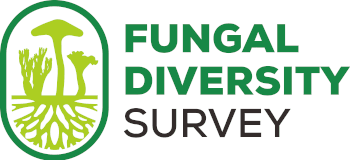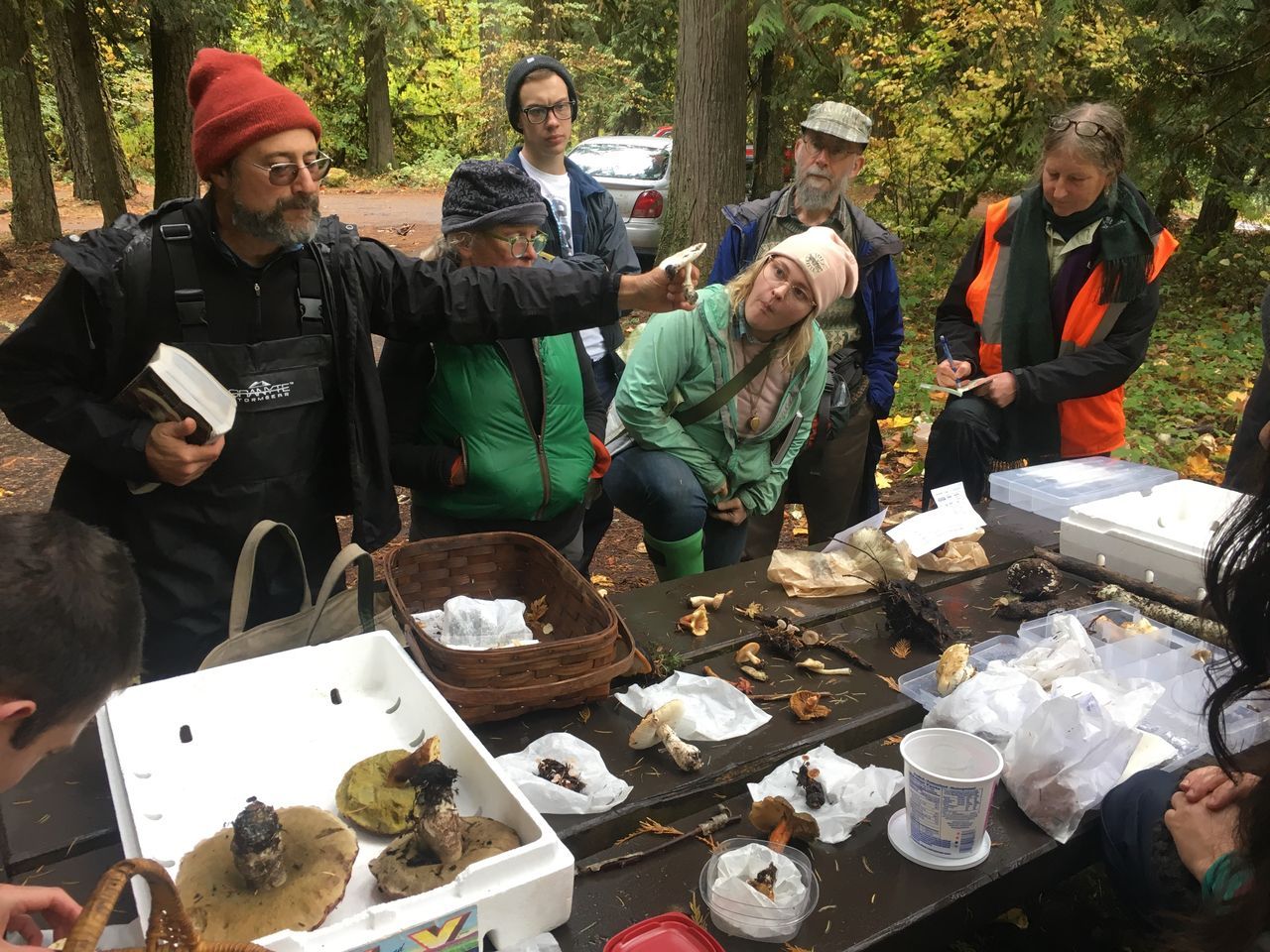In March of 2018 I and four fellow members of my local mushroom club, the Cascade Mycological Society, got together over a beer and decided it was time to step up our game. We’d been collecting and documenting the fungi of Lane County, Oregon for a long time, but beyond species lists from the annual fall mushroom show, we did not have a good idea of how many species we had, or when and where they fruited.
We also knew there were a lot of species groups, such as Polyozellus and Xerocomellus, that were likely more than one species, and we were not always sure of our IDs of rarer species or difficult genera. So when we heard that NAMP was giving out grants for sequences, we decided it was time to get serious.
Deciding on a database
Every NAMP project needs a database to house its observation data. We ended up choosing iNat over Mushroom Observer. We liked that iNat uses open source software, has a free app and allows for easy data downloads into customizable spreadsheets. It’s also backed by the California Academy of Sciences and National Geographic, and it’s one of the largest free citizen science data repositories in the world and increasingly the standard for professional biologists. We were also impressed by its forums, and a robust help system including a very responsive email helpline (This email address is being protected from spambots. You need JavaScript enabled to view it.).
Choosing an iNat project type
INat projects are a way of grouping your observations together, like placing photographs in an album. We had the option of either starting a traditional project or a collection project. Following a discussion with Noah Siegel (co-author of Mushrooms of the Redwood Coast) we chose a traditional project because it gave us greater control and encouraged higher quality observations by allowing us to add additional fields such as voucher collected, habitat type and associated trees. The downside: those observations need to be added to our project manually, unlike collection projects that automatically add observations within a delineated area.
Adding observations to an iNat project
The next step was to encourage club members to sign up to iNat, join our project and add their own observations to it. But this doesn’t always happen. This is where project coordinators like myself come in - I’ll search the Lane Country area for suitable observations and manually add them to the project. To encourage greater participation in the future I’ll also leave this comment:
“Hi, thanks for photographing fungi! Taking and posting more photos is always good. Having photos of the underside gills/pores/teeth and stems as well as the cap will help with ID. Consider joining the Mushrooms of Lane County Project. All photographs added to this project will be identified or verified by local experts, as best we can (depends on how good the photos are and the fungus in question, and maybe not right away, but soon). The data will be used to document what fungi we have in Lane county, their geographic ranges, and when they fruit (i.e., phenology). You will benefit from verification of ids, being able to see fungi from the same region, and being part of this cool project. For more information see: http://cascademyco.org/mlco/how-to-take-photos-for-mlco/.”
Improving the quality of an iNat project
Great iNat projects don’t just happen by themselves - they need ongoing management. Just gathering observations is not enough. Identifying what club members find and teaching them how to do IDs themselves is a great way to keep participants engaged. We’ve assembled a small team to do these identifications - two members of the founding team as well as two experts in our local fungi. We use the commenting function in iNat to educate participants on how to take better photos, to let people know when their find is unusual or even new to the county, as well as to ask lots of questions.

Our results so far
Your iNat project will become an increasingly valuable tool over time. We started ours, https://www.inaturalist.org/projects/macrofungi-of-lane-county-oregon , on the 5th of March 2018. As you can see in Figure 1, as of the 11th of May 2020, we have 6250 observations of 760 species made by 573 people, of whom 212 are members of the project. It is now possible to use our iNat project as a guide to our local fungi! We also know from our iNat records that we have dried specimens of about 350 of our 760 species to date (more species are added all the time). Only 40 of the 760 have been sequenced so far, but we are ready to ship another 96 the minute the moratorium on sequencing lifts. Of the 40 we sequenced, five (13%) may be new species (not in Genbank and not in the literature so far), but we need to work more on these to be sure. In addition, we were able to attach names to some mystery Mycena, Russula and Inocybe, and added a new Agaricus to the state, Agaricus porphyrocephalus.
Funding our sequencing efforts
Early on we realized that we’d have to raise funds for our sequences. Our initial grant of 30 sequences was a great start but not nearly enough for our needs. There were so many interesting taxa in our forests that belonged in species “groups”, and many others that none of us knew. To fund additional sequences we raised money in a number of ways: we held a science talk at a bar, our club’s incredible web person Sandy made and sold mushroom earrings, the club donated some money, individuals donated, and we collaborated with the forest service to buy some sequences to help with their surveys. We also applied for a small grant to the Stuntz Foundation specifically for money to sequence our wood chip fungi, most of which are little brown jobbers that are not well known.

Educating members on NAMP protocols
With the iNat framework and funding in place, our next task was to educate club members. We first developed protocols on how to use iNat and how to photograph mushrooms, which are now on the NAMP resources page (https://mycoflora.org/index.php/component/sppagebuilder/79-level-1-resources). We then led a series of forays (Fig. 2) to teach members how to use iNat in the field and how to collect and photograph good specimens. One of the most critical things for everyone to learn is that the iNat observation number is the collection number and it must be kept with the specimen as this is how the specimen is linked to the photograph and to the DNA sample (See Box 1).
______________________________________________________________________________________________
Box 1. How to find the iNat observation number, which is also the collection number.
-On a computer it is the number at the end of the URL for the observation (for example, the bolded part of this url: https://www.inaturalist.org/observations/35843490)
-On an iPhone, go to the photo of an observation, click on the share icon, open the browser, click on the URL and there it is - it’s the last part of the URL.
-On an Android phone, click the photo and look for a very cryptic icon in the upper right, click on this and it will lead you to the URL.
______________________________________________________________________________________________
Interpreting sequences
We highly recommend forming a taxonomy/microscopy working group to follow up on sequencing results. For example, several of our specimens’ sequences did not have a close match in Genbank. This could be because the fungus has been described but not yet sequenced, or it could be that it is new to science. In both cases it is essential to follow-up with microscopy and a literature review. The taxonomy working group also decides what specimens merit sequencing. This group was initially organized by the five members of the founding group, but we have started inviting new attendees based on how many observations they make in iNat - it’s a great way to gauge and reward interest.
Keeping club members engaged
It is important to keep engaging with the entire club. Collecting forays are always fun and wonderful. We also give regular updates at meetings. For example, five minutes of showing people what is on iNat and how to use it as an identification tool and information source, or a talk about what has been learned from sequencing. Get other club members to participate with this, when you can. Two students documenting our local woodchip fungi were supposed to give a talk in May, but were derailed by COVID.
Key lessons learned
- Having someone help with iNat and other issues at the start is helpful. Feel free to make use of this blog, the materials on the NAMP website, or contact me (This email address is being protected from spambots. You need JavaScript enabled to view it.). A few minutes’ conversation can save a lot of time.
- An excellent and interactive webmaster, someone who posts all the information on line, is essential for club communication
- Dealing with sequencing results comes with a learning curve; ask for help or see if you can get a local mycologist involved
- Helping each other with IDs on iNat is critically important, so be sure you have a group of local experts willing to spend time identifying iNat observations
- Keep working with the club on how to use iNat to its full advantage. Show them at meetings why it is useful.
Acknowledgements
Thank you to all the other Lane County Macrofungi Project committee members: Bruce Newhouse, Susie Holmes, Roo Vandegrift and Cheshire Mayrsohn and our webmaster/ editor Sandy Patton and to all the other members of the Cascade Mycological Society.





